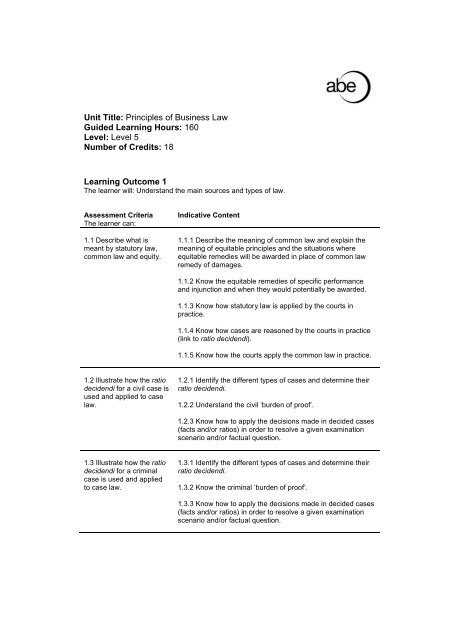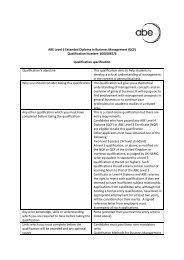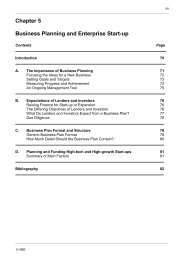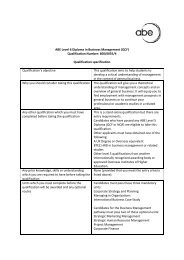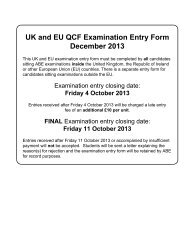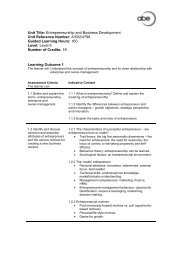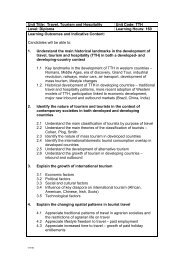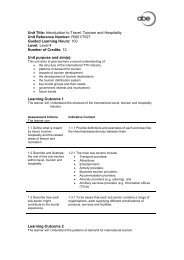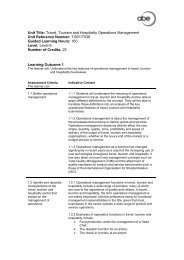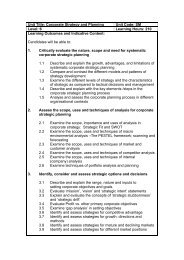Principles of Business Law - Association of Business Executives
Principles of Business Law - Association of Business Executives
Principles of Business Law - Association of Business Executives
Create successful ePaper yourself
Turn your PDF publications into a flip-book with our unique Google optimized e-Paper software.
Unit Title: <strong>Principles</strong> <strong>of</strong> <strong>Business</strong> <strong>Law</strong>Guided Learning Hours: 160Level: Level 5Number <strong>of</strong> Credits: 18Learning Outcome 1The learner will: Understand the main sources and types <strong>of</strong> law.Assessment CriteriaThe learner can:1.1 Describe what ismeant by statutory law,common law and equity.Indicative Content1.1.1 Describe the meaning <strong>of</strong> common law and explain themeaning <strong>of</strong> equitable principles and the situations whereequitable remedies will be awarded in place <strong>of</strong> common lawremedy <strong>of</strong> damages.1.1.2 Know the equitable remedies <strong>of</strong> specific performanceand injunction and when they would potentially be awarded.1.1.3 Know how statutory law is applied by the courts inpractice.1.1.4 Know how cases are reasoned by the courts in practice(link to ratio decidendi).1.1.5 Know how the courts apply the common law in practice.1.2 Illustrate how the ratiodecidendi for a civil case isused and applied to caselaw.1.2.1 Identify the different types <strong>of</strong> cases and determine theirratio decidendi.1.2.2 Understand the civil ‘burden <strong>of</strong> pro<strong>of</strong>’.1.2.3 Know how to apply the decisions made in decided cases(facts and/or ratios) in order to resolve a given examinationscenario and/or factual question.1.3 Illustrate how the ratiodecidendi for a criminalcase is used and appliedto case law.1.3.1 Identify the different types <strong>of</strong> cases and determine theirratio decidendi.1.3.2 Know the criminal ‘burden <strong>of</strong> pro<strong>of</strong>’.1.3.3 Know how to apply the decisions made in decided cases(facts and/or ratios) in order to resolve a given examinationscenario and/or factual question.
Learning Outcome 2The learner will: Understand the different types <strong>of</strong> business organisation.Assessment CriteriaThe learner can:Indicative Content2.1 Describe whatconstitutes a traditionalpartnership or firm underthe Partnership Act 1890.2.1.1 Know what constitutes a partnership (or firm) under thePartnership Act 1890.2.1.2 Know the different types <strong>of</strong> partner which a firm can have.2.1.3 Understand the different types <strong>of</strong> partner a firm can have,including a partner acting as an agent. Understand the rightsand duties <strong>of</strong> partners in their capacity as agents for their firm inthe absence <strong>of</strong> an agreement to the contrary.2.1.4 Know that the liability <strong>of</strong> partners, in the absence <strong>of</strong> apartnership agreement to the contrary, is joint and several.2.1.5 Know how firms can be dissolved, and that it is possible,in the absence <strong>of</strong> a partnership agreement to the contrary, for afirm to be dissolved with or without statutory intervention.2.2 Describe thedifferences between a‘traditional’ partnership anda limited liabilitypartnership, which isgoverned primarily by theLimited LiabilityPartnerships Act 2000.2.2.1 Know the main differences between a traditionalpartnership and a limited liability partnership (LLP), which isgoverned primarily by the Limited Liability Partnership Act 2000,and the Limited Liability Partnership Regulations 2001 whichdetail the rights <strong>of</strong> members <strong>of</strong> the LLP.2.2.2 Know that an LLP has a separate corporate personality.2.2.3 Know that an LLP normally has to have a writtenincorporation document, which has to be submitted to theRegistrar <strong>of</strong> Companies.2.2.4 Any member who wishes to leave an LLP can do so inaccordance with the LLP agreement. Where no agreementexists, the member can leave by giving reasonable notice.2.2.5 Know that members <strong>of</strong> an LLP normally will not contributein the event <strong>of</strong> the LLP being wound up.2.2.6 Be aware that substantial portions <strong>of</strong> the Companies Act2006 apply to LLPs, e.g. the minority protection provisions.2.2.7 Be aware that a member <strong>of</strong> an LLP can be disqualifiedfrom being an LLP member or company director under theCompanies Directors Disqualification Act 1986 and that amember <strong>of</strong> an LLP can be charged with fraudulent trading.2.3 Describe whatconstitutes a registeredcompany limited by2.3.1 The effect <strong>of</strong> registration and becoming a body corporate,under the Companies Act 2006, following receipt <strong>of</strong> the newcompany’s certificate <strong>of</strong> incorporation.
legal relations.3.3.2 Know how the courts find whether a commercialagreement is, or is not, legally binding.3.4 Define and explain thelaw relating toconsideration.3.4.1 Know what constitutes valid consideration.3.4.2 Know the three different types <strong>of</strong> consideration.3.4.3 Know that the performance <strong>of</strong> an existing contractualobligation does not constitute sufficient consideration.3.4.4 Know that performance <strong>of</strong> an existing public duty doesnot constitute sufficient consideration.3.4.5 Know the rule in Pinnel’s case (1602) and its exceptions,and, be able to apply it in practice.3.5 Distinguish between a 3.5.1 Distinguish between a term and a representation.term and a representation.The 3.5.2 Know that the remedy available for a breach <strong>of</strong> contractdepends on whether the particular wording <strong>of</strong> a statement is aterm or a representation.3.5.3 Know that whether a statement becomes a term <strong>of</strong> thecontract or not depends on the intention <strong>of</strong> the parties.3.5.4 Know that four factors may be taken into account by thecourts when ascertaining the intention <strong>of</strong> the parties: theimportance <strong>of</strong> the statement to the parties; the respectiveknowledge <strong>of</strong> the parties; the time the statement was made,and whether the statement is included in a written contract.3.6 Define and explain thedifferent types <strong>of</strong>contractual terms.3.6.1 Know what an express contractual term is.3.6.2 Know what a condition is.3.6.3 Know what a warranty is.3.6.4 Know the difference between a condition and a warranty.3.6.5 Know what an innominate term is.3.6.6 Know what an exclusion clause is.3.6.7 Know the three ways that exclusion clauses maybecome incorporated into a contract under the common law.3.6.8 Know about unfair contractual terms in the context <strong>of</strong>exclusion clauses only.3.6.9 Know what a penalty clause is.3.7 Define and explain the 3.7.1 Know what constitutes duress including economic
law in relation to vitiatingfactors.duress and undue influence.3.7.2 Know about the types <strong>of</strong> misrepresentation.3.7.3 Identify and explain when a contract is void or illegal.3.7.4 Understand what a restraint <strong>of</strong> trade clause is, and beaware <strong>of</strong> the reasons for their existence in contracts.3.7.5 Know the rules in relation to contracting with minors.Learning Outcome 4The learner will: Understand the law on discharge and breach <strong>of</strong> a contract.Assessment CriteriaThe learner can:4.1 Discuss the variousforms <strong>of</strong> discharge <strong>of</strong>contract.Indicative Content4.1.1 A person must perform exactly what he has promised todo. Doing something differently from that which has beenagreed, even though it may be commercially more valuable tothe other party, is not performance in law. Even the slightestdeviation from the agreed terms will entitle the other party toclaim that the contract has not been performed.4.1.2 Know what is meant by prevention <strong>of</strong> performance.4.1.3 Know what is meant by partial performance, and whetherit can ever be accepted by the other party.4.1.4 Know what is meant by substantial performance.4.1.5. Know that there are four ways in which a contract can bedischarged by agreement: by release; by accord andsatisfaction; by rescission, and by some provision contained inthe contract itself.4.1.6 Know the various different ways in which a contract canbecome frustrated and be able to apply relevant law to ascenario.4.2 Explain the rules andremedies which arerelevant to parties in theevent <strong>of</strong> a breach <strong>of</strong>contract.4.2.1 Know that all ‘breaches <strong>of</strong> contract’ entitle the innocentparty to damages, but the right to treat the contract asdischarged (at an end) arises only if the breach is serious, e.g.where there has been a breach <strong>of</strong> a fundamental condition <strong>of</strong>the contract.4.2.2 Know the consequences <strong>of</strong> a failure <strong>of</strong> performance.4.2.3 Know about anticipatory breach.4.2.4 Know the rule in Hadley v Baxendale.
4.2.5 Be able to apply the rule in Hadley v Baxendale to ascenario question, as well as discuss the elements <strong>of</strong> this ruleindividually.4.2.6 Know about the common law remedy <strong>of</strong> damages.4.2.7 Know that all claimants have a duty to take reasonablesteps to mitigate their loss, e.g. by looking for otheremployment.Learning Outcome 5The learner will: Know and understand the legal rules in relation to agency.Assessment CriteriaThe learner can:5.1 Identify what is meantby an agent and a principaland describe their rightsand duties.Indicative Content5.1.1 Know what is meant by an agent in the law <strong>of</strong> agency.5.1.2 Know the rights <strong>of</strong> an agent.5.1.3 Know the duties <strong>of</strong> an agent.5.1.4 Know the Commercial Agents (Council Directive)Regulations 1993.5.2 Describe how anagency relationship can becreated and terminated.5.2.1 Know that an agency can be created by expressagreement or implied agreement.5.2.2 Know that an agency can be created by estoppels, e.g. ifyou have a reasonable belief that an individual has the right toact for another party (the principal).5.2.3 Know that an agency can be created by necessity incertain circumstances, and what these are.5.2.4 Know that an agency can be created by ratification and asa result <strong>of</strong> the principal taking the decision to ratify the act(s)concerned.5.3 Identify the differenttypes <strong>of</strong> agent and thedifferent types <strong>of</strong> authoritythat an agent can have.5.3.1 Know all the different categories <strong>of</strong> agent, includingcommercial agents under the 1993 Regulations (see above).
Learning Outcome 6The learner will: Know the legal rules in relation to the areas <strong>of</strong> employment law identified.Assessment CriteriaThe learner can:6.1 Distinguish between acontract <strong>of</strong> service and acontract for services andexplain how the courtsdetermine a worker’s trueemployment status.Indicative Content6.1.1 Know that there are two different types <strong>of</strong> employmentstatus that a worker can have: (1) employee (employed under acontract <strong>of</strong> service); (2) an independent contractor (employedunder a contract for services).6.1.2 Today the multiple test is the only test which is applied bythe courts to find out a worker’s true employment status. Theoriginal multiple test was later amended by the entrepreneurialtest and it should, therefore, be seen as an expansion <strong>of</strong> theoriginal multiple test in the Ready Mixed Concrete case (1968).The second and third conditions <strong>of</strong> the original test areimportant when applying the entrepreneurial test to the originalmultiple test in order to determine whether a worker is anemployee in reality.6.2 Identify the legal andeconomic consequencesassociated with a contract<strong>of</strong> service and a contractfor services.6.2.1 Employment protection rights. Only employees have thefollowing statutory rights, assuming that in redundancy andunfair dismissal cases they have accrued the qualifying period<strong>of</strong> continuous service (respectively two and one years): toreceive a minimum period <strong>of</strong> notice <strong>of</strong> his employer’s intentionto terminate his employment, and receive a written statement <strong>of</strong>employment particulars within two months <strong>of</strong> thecommencement <strong>of</strong> employment. Remember that the courts lookat the contractual terms <strong>of</strong> a worker as a whole and takesubstance (i.e. what has been concluded about the othercontractual terms) over form for tax purposes. So just becauseit says in a question that a worker is self employed it does notmean that, in reality, they are.6.2.2 Common law employment terms are implied in allcontracts <strong>of</strong> employment. Some <strong>of</strong> the most important ones are:mutual trust and confidence; the duty <strong>of</strong> an employer to protectall his employees against reasonably foreseeable risks to theirhealth, safety and welfare; entitlement to welfare benefits e.g.statutory maternity pay and a higher rate <strong>of</strong> sick pay; liability forincome tax varies as to whether you are classed as anemployee or independent contractor.6.2.3 Vicarious liability: an employer is generally vicariouslyliable for the negligent acts committed by his employees duringthe course <strong>of</strong> their employment, but such liability is severelyrestricted in the case <strong>of</strong> a contract for services. The employerwill normally only be liable in such circumstances if hedelegated performance to another. Whether or not an employeeis ‘acting in the course <strong>of</strong> employment’ is a question <strong>of</strong> fact.6.3 Identify the impliedduties owed by an6.3.1 There are six implied common law duties owed by anemployer towards his employees, as specified below:
employer to hisemployees.6.3.2 Payment <strong>of</strong> reasonable remuneration. This common lawrule can be varied by an express or implied term to the contrary.Thus if the contract states that there shall be no payment duringa lay-<strong>of</strong>f or in respect <strong>of</strong> short-time working, the employer willbe under no obligation to pay.6.3.3 To indemnify his employees for expenses reasonablyincurred in the course <strong>of</strong> their employment.6.3.4 Protection against reasonably foreseeable risks to theirhealth, safety and welfare, which include psychiatric injurysustained e.g. as a consequence <strong>of</strong> work-related stress.6.3.5 To maintain mutual trust and confidence. The employerhas a duty not to behave in a manner judged to damage therelationship <strong>of</strong> trust and confidence.6.3.6 To provide a reference. An employer is under no legalobligation to provide an employee or an ex-employee with areference.6.3.7 Not to disclose confidential information to third partiesabout his employees ‘without their permission’.Assessment:• Assessment method: written examination (unless otherwise stated).• Written examinations are <strong>of</strong> three hours’ duration.• All learning outcomes will be assessed.Recommended Reading:• <strong>Principles</strong> <strong>of</strong> <strong>Business</strong> <strong>Law</strong> – ABE Study Manual.• Please refer to the Tuition Resources section <strong>of</strong> the Members Area <strong>of</strong> the ABEwebsite (www.abeuk.com) for further recommended reading.


